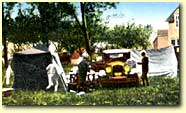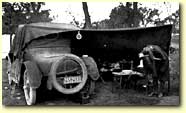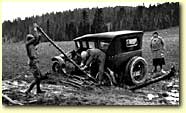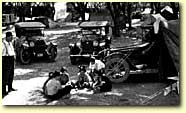 For men as rich and powerful as Henry Ford, Thomas Edison, and President Warren
G. Harding, a luxurious vacation seemed the right choice. Like other wealthy
Americans, they could pick from numerous voyages on trains and classy passenger
ships to vacation spots such as Miami Beach, Los Angeles, Cuba, or the
Mediterranean.
For men as rich and powerful as Henry Ford, Thomas Edison, and President Warren
G. Harding, a luxurious vacation seemed the right choice. Like other wealthy
Americans, they could pick from numerous voyages on trains and classy passenger
ships to vacation spots such as Miami Beach, Los Angeles, Cuba, or the
Mediterranean.
But like many Americans in the early 1900s, these influential men had
discovered a whole new type of vacationing. It was called
"gypsying," or autocamping, and Ford and his friends seemed to
love it. Newspapers and magazines carried photos of them camped by the side
of the road with their automobiles, obviously enjoying the outdoor life. Maybe
Ford was using the publicity to sell more cars. Maybe he wasn't. But one
thing was certain. Autocamping was becoming more and more popular.
 Autocamping was simple and not a lot different from a
car vacation of today. You packed your car with food, clothes, blankets, and
other necessities. Then you drove out to the country, found a beautiful spot
along a river, a pasture, or a mountainside, and set up camp. For the next day,
week, or even month, you could live a life of leisure.
Autocamping was simple and not a lot different from a
car vacation of today. You packed your car with food, clothes, blankets, and
other necessities. Then you drove out to the country, found a beautiful spot
along a river, a pasture, or a mountainside, and set up camp. For the next day,
week, or even month, you could live a life of leisure.
Autocamping was simpler than luxury vacations and a lot cheaper,
besides. Many Americans couldn't afford the cost of top-notch hotels or
cruise ships. At resorts, you needed to practice good table manners, and you
might even have to put on a suit just to eat dinner. And trains and steamships
ran on schedules. You could only go where they were going, and when they were
scheduled to go there.
 But with your car, you had freedom. Gypsying became
popular almost as soon as cars hit the roads. Car campers traveled to places as
close as a farm outside of town or as far away as the Grand Canyon. They slept
in tents or built lean-tos, small shelters made of materials like canvas and
tree branches. They cooked fresh-caught fish and cooked warmed cans of soup
over campfires.
But with your car, you had freedom. Gypsying became
popular almost as soon as cars hit the roads. Car campers traveled to places as
close as a farm outside of town or as far away as the Grand Canyon. They slept
in tents or built lean-tos, small shelters made of materials like canvas and
tree branches. They cooked fresh-caught fish and cooked warmed cans of soup
over campfires.
 Autocampers loved this rough life. But what they didn't love was the
rough roads they had to travel. In the early years of the car, roads
weren't much better than buggy paths. Mud holes, ruts, and boulders
often blocked the way. Bridges over rivers and streams were few and far
between. Highway route markers didn't exist, and many roads
didn't appear on the maps. Smart auto gypsies carried repair kits and
even cans of gasoline in case of emergencies.
Autocampers loved this rough life. But what they didn't love was the
rough roads they had to travel. In the early years of the car, roads
weren't much better than buggy paths. Mud holes, ruts, and boulders
often blocked the way. Bridges over rivers and streams were few and far
between. Highway route markers didn't exist, and many roads
didn't appear on the maps. Smart auto gypsies carried repair kits and
even cans of gasoline in case of emergencies.
Soon, that would all change. Across America, car builders, car dealers,
motorists, and local chambers of commerce began to form trail associations,
which worked to make roads better. The associations gave highways
attention-getting names such as the National Old Trails Highway, the Mohawk
Trail, and the Dixie Highway. They put up road signs and mileage markers,
printed trail maps and promotional brochures, and lobbied for money to improve
roadways.
 The efforts paid off. In 1921, Washington State built 200 miles of concrete
road, including stretches of the Pacific Highway, which became a favorite of
auto tourists. That same year, New York State paved 530 miles. Pennsylvania
added 640 miles, more than any other state in the nation. Better roads drew
more tourists to the highway and that meant more autocampers.
The efforts paid off. In 1921, Washington State built 200 miles of concrete
road, including stretches of the Pacific Highway, which became a favorite of
auto tourists. That same year, New York State paved 530 miles. Pennsylvania
added 640 miles, more than any other state in the nation. Better roads drew
more tourists to the highway and that meant more autocampers.
But as the number of autocampers grew, so did the problems. Campers trespassed
on private property. They polluted streams with sewage, threw garbage all over,
and helped themselves to farmers' fruits and vegetables without
bothering to pay. More and more people began to complain about autocampers.
 Eager to control autocamping and to make money from it, thousands of
communities set up auto camps on public land. Campers could get a hot meal, a
shower, and a camping spot in a safe, secure environment. This drew people in,
but created another problem. Some people decided to move into auto camps full
time. Soon, many auto camps were charging fees to try to keep the full-timers
out.
Eager to control autocamping and to make money from it, thousands of
communities set up auto camps on public land. Campers could get a hot meal, a
shower, and a camping spot in a safe, secure environment. This drew people in,
but created another problem. Some people decided to move into auto camps full
time. Soon, many auto camps were charging fees to try to keep the full-timers
out.
By about 1925, businesspeople began building groups of tiny cabins and charging
autocampers to stay in them. So-called "tourist courts" proved
very popular. As competition grew, owners used gimmicks to attract travelers.
They modeled their shelters on tipis, log cabins, or southwestern-style adobe
buildings. They offered cooking stoves and hot showers. And eventually, they
linked their cabins together in a single building, creating what we now know as
the motel.
As time passed, motel visitors wanted more and more luxuries. Motels became
more like luxury hotels, as owners added dining rooms, swimming pools, and air
conditioning. America, the car and the family vacation were now completely
connected. But car camping, which was once so popular, had become a thing of
the past.
This summer, families all across America will hit the road for a vacation. If
your family is one of them, send a postcard and tell your friends about your
experience. Did you see any old-style motels or tourist cabins? Did you even
stay in one of them? And how does vacationing by car today different from car
camping? Send a free email postcard, and share your thoughts
with the folks back home.
|
|

